Ms Pragya Goswamy participated in the JENESYS 2019 programme at Tokyo, Japan for students of Agriculture and Allied Disciplines from SAARC countries from 25 November to 3 December, 2019. She shares her experience here.
CONTEXT
Japan’s Ministry of Foreign Affairs conducts Japan’s Friendship Ties Programmes to promote people-to-people exchange between Japan and the various nations of the Asia-Pacific, North America, Europe, Latin America, and Caribbean regions. The Asian and Oceanian regional component of this exchange programme is called ‘JENESYS’. The Japan International Cooperation Center (JICE) conducts JENESYS in cooperation with various local institutions and international exchange organizations. JENESYS 2019 was specifically for the school and college students of the eight SAARC member countries (India, Nepal, Bhutan, Sri Lanka, Maldives, Afghanistan, Pakistan, and Bangladesh), with focus on Agriculture. Eighty youths – comprising 50 college students and 30 school students along with one supervisor from each nation – participated in the programme from 25 November to 3 December, 2019 at Tokyo, Japan.
Objectives of JENESYS 2019
- Promote mutual trust and understanding among the people of Japan and the Asia-Pacific region to build a basis for future friendship and cooperation.
- Promote global understanding of Japan’s economics, agriculture, society, politics, diverse culture, history, foreign policy and diplomatic relations.
- Convey information on Japan to the general public of SAARC member countries through the participants of this project.
- Promote participants’ capacity building in a manner that would be conducive to the development of SAARC member countries.
Participants from India
Ten youths participated in the programme this year. The group consisted of five college students of agriculture and allied disciplines – one each from Govind Ballabh Pant University of Agriculture & Technology, National Dairy Research Institute, Indian Veterinary Research Institute, Central Institute of Fisheries Education and Forest Research Institute; four school students from the states of Maharashtra, Gujarat, Madhya Pradesh and Chhattisgarh; and one supervisor from the Indian Agriculture Research Institute.
PROGRAMME
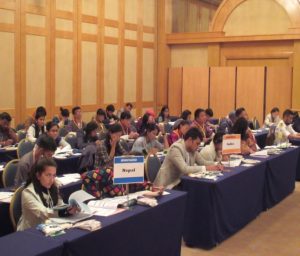 Day 1: Orientation to learn and be safe
Day 1: Orientation to learn and be safe
The programme started with a formal inauguration and welcome. This was followed by an orientation programme to explain the programme’s objectives, detailed schedule, and the role of participants. A programme handbook and itinerary with more details of the programme was also given to each participant. The day ended with dinner at an Indian restaurant.
Day 2: Transforming agriculture into ‘smart agriculture’
The second day started with a keynote lecture by a Representative from the Ministry of Agriculture, Forestry and Fisheries, Japan, on ‘Situation of Japanese agriculture, forestry and fisheries administration’ with emphasis on promoting smart agriculture by disseminating cutting-edge agricultural technologies, which also provided a glimpse of agriculture in Japan. It also highlighted how domestic production from food industries contributes 11.4% to the total economy of the country, despite many challenges, including a decline in population (particularly in hilly and mountainous areas in Japan) along with growth in the ageing population with the core having an average age of 67 years. The Agriculture, Forestry and Fisheries Industries/Regional Vitality Creation Plan that indicates the critical concerns pertinent to agriculture and allied sectors in Japan and the major steps planned to address those concerns are presented in Table 1.
Table 1: Critical concerns related to Agriculture & allied sectors in Japan and major steps planned to address those concerns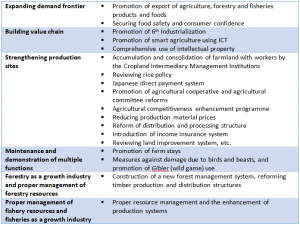
Japan is focusing on Smart Agriculture in a major way, through a combination of agriculture and advanced technologies such as unmanned robot tractors, smartphone-operated water management system, automatic rice planting machines, automatic water management systems, remote sensing using drones, irrigation fertilization automation system, agricultural assist suit, unmanned mowing machine, tomato harvesting robot, strawberry harvesting robot, and ICT-enabled technology dissemination among farmers. Attention was drawn to ‘WAGRI’ (a term coined from a combination of Japanese words), a nationwide agricultural data collaboration platform that recently came into operation – since April 2019 – in Japan. It operates in a business-to-business-to-customer model (B2B2C model), offers agriculture-related data on fertilizers, pesticides, farmlands, weather, soil, and rice varieties, and acts as an interface between data providers and users. The keynote lecture elaborated on Japan’s commitment to move towards strengthened and advanced agriculture. After the keynote lecture, all the participants were divided into three groups. The group members were expected to move within their respective groups to all destinations.
Dr Osaki, one of the researchers on the Peach Tree Form, explained that the V-tree form of peach trees has three times higher yield than conventional trees, and these also start fruiting from the third year itself. Fruit picking was also found to be more convenient for ageing farmers in this system.
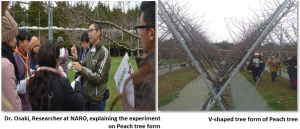
Thereafter, participants visited the National Agriculture and Food Research Organization (NARO) Genebank. At present, the Central Genebank of NARO has four sections i.e., plant, microorganism, animal, and DNA sections. A massive collection of 2,28,000 plant accessions are stored in the Genebank, including landraces, improved varieties and wild relatives of rice, wheat, barley, pulses, fruit trees, vegetables, etc. This was followed by a visit to the Artificial Light Plant Factory, wherein, crops are produced round-the-year in an integrated controlled environment.

The day ended with a visit to the museum at NARO, with a demonstration of cutting-edge technologies developed by NARO, which included the world’s first blue color transgenic variety of chrysanthemum, and silk fibers containing fluorescent proteins of different colors. It was inspiring to see the original cultivars of several varieties, including ‘Fuji’ apple, ‘Shine muscat’ grape, ‘Yumechikara’ wheat, ‘Nikomaru’ rice, and ‘Benifuuki’ developed by NARO.
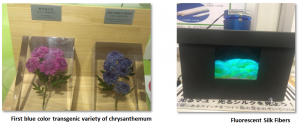
Day 3: Visit to a University – A building place for nation-builders
Our visit to the Tokyo University of Agriculture, abbreviated as NODAI or Tokyo NODAI was insightful. Viscount Enomoto Takeaki founded the University in 1891 with its main campus in Setagaya. It is a private institution of higher education with multiple departments under Faculties of Agriculture, Applied Bioscience, Life Sciences, Regional Environment Science, Bioindustry, and International Agriculture and Food Studies. While most of the programmes are conducted in Japanese, a new programme called ‘Agriculture, Food and Environment’ with 26 specialized courses was introduced in April 2014, in English. It provides an opportunity for Japanese and international students, including visiting students from global partner universities to learn about food, agriculture and environment in Japan and Asia. We met one such student, Mr. Parminder Chaudhary from Haryana, India, who was pursuing BSc Agriculture in NODAI under the student exchange programme between Chaudhary Charan Singh Haryana Agricultural University (CCSHAU), Haryana, and NODAI. He explained to us how and why practical exposure is the main focus of their curriculum with limited theoretical classes. Our visits to the laboratories, classrooms, library and museum on the NODAI campus was helpful.
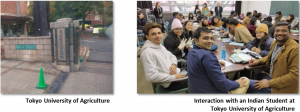
The University library operating from the third to the seventh floor of the NODAI Academia Center has a huge collection of print holdings as well as electronic resources. The Food and Agriculture Museum in NODAI is a place that keeps the history of farming in Japan alive. The origin of the museum is traced back to the specimen room that was established in 1904 by Yoshio Tanaka, who is known as ‘the Father of Japanese Museums’. The museum exhibits the history of the University. It also holds several collections – one such gathers together academic specimens of approximately 120 kinds of Japanese and foreign chicken breeds, another huge cupboard shows off a large number of sake bottles (‘Sake’ is a fermented rice wine made with high-quality rice and pure water in cool climatic environs). There’s also an old folk house with antique farm tools. It was indeed a great day for us as we learned of the structure and functioning of an agricultural university in a foreign country.

Day 4: An open field opens up the mind
The day started at Hakuba village, which is located in the Northern Alps region of Nagano Prefecture, one of the 47 prefectures in Japan. The village has gained worldwide recognition as it had hosted the 1998 Nagano Winter Olympics. Round-the-year, people visit Hakuba drawn to its beautiful scenic valley, tourism spots and world-class snow sports facilities. All these attributes become resources for the villagers’ livelihood. Majority of them own resorts or hotels. The village looks picturesque with apple orchards heavily laden with red-ripe fruits, and persimmon trees all round, both domesticated and wild, in the entire Prefecture.

The day led up to another visit in Nagano, to Oyaki village. It is famous for Oyaki or Japanese dumplings, a major source of livelihood especially in winters. Oyaki is a bun or dumpling made from water-kneaded wheat or buckwheat dough that contains vegetables or sweet bean fillings. It is packed and sold through departmental stores and supermarkets in Japan. The socio-economic status of Oyaki’s people was lower than those of Hakuba village as the former are mostly engaged in agriculture in summer and oyaki making in winter. The highlight of the day, for us was in tasting and relishing the oyaki baked by us through a session of ‘learning by doing’. Experiencing spiritualism at Zenkoji temple, which is one of the national treasures of Japan, was the last call of our day. Zenkoji is a non-sectarian temple where all are welcome, regardless of gender, creed or religious belief.
Day 5: Daihoku Agricultural Cooperative – The case for ‘Together we can achieve more’
The day started at a skiing site in Hakuba valley and on to Daihoku Agricultural Cooperative (JA Daihoku). The Heads of Agricultural Management Department and Financial Department of the Cooperative explained the organizational structure and functions of the JA Cooperative. JA Daihoku was established in 1996 by amalgamating 13 agricultural cooperatives in Omachi city and Kitaazumi district. It is strengthening the agricultural production base and maintaining the production capacity of agricultural products by strengthening support for farming management, increasing agricultural income, and creating a system that connects regions, technologies and agriculture. The members also grow cabbage in a large area, which is then sold to the supermarket and restaurant industries. By August 2018, the number of members in JA Daihoku had grown to 12,722 across 9,011 households. A unique feature of JA Daihoku in particular, and Japan Agricultural Cooperatives in general, is the direct sale business of agricultural and livestock products through direct sale shops in local areas. Japan Agricultural Cooperatives work on the ‘Chisan-Chicho’ initiative, which encourages members to sell their produce locally so as to avoid unnecessary transportation of crops, and thus reduce food miles. In the afternoon, it was a joy to visit an apple farm where we learned the recommended practices for picking red, ripe Nagano apples that can extend its shelf life. Packaging matters in consumerism. The JA direct sale shop showed its consumerism by exhibiting the packed agricultural and livestock products with a tag bearing the information of the producer – thus helping to increase both reliability and credibility of the product and strengthening the direct relationship between producer and buyer.

Our visit to Matsumoto Castle was enchanting, a striking and impressive cultural heritage site which soars against a backdrop of the Northern Alps. Its exterior is characterized by the contrasting hues of black and white, which earned the castle the nickname of ‘Crow Castle’. It is one of the five castles of Japan, which are designated as national treasures. Its elegant six-story tenshu (donjon), is the oldest tower of its kind existing in Japan. The castle was a residence for warriors, built in a way that makes it ever-ready for any kind of war. The entire architecture of the castle reflects the innovative outlook of the Japanese people. The day ended with us meeting the host families for homestays. One of the components of the JENESYS programme is the homestay – in small groups with different Japanese families. Two other girls and I stayed with the Shimokawa family, in their home filled with hospitality and kindness.
Day 6: One day and a journey with the Shimokawa family
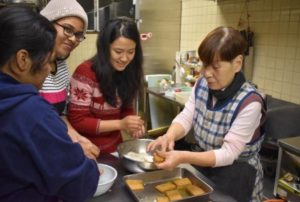 “The day you decide to do it is your lucky day” – goes a Japanese proverb – and it was such a day for us with the Shimokawa family comprising septuagenarian parents and their middle-aged son. The homestay truly gave us a feeling of a home away from home. Our ‘we feeling’ was strengthened by calling the elderly parents as Okaasan (mother) and Otousan (father). It became apparent to us that though Japan is moving towards an ageing population, age does not matter for the elders of Japan. It is remarkable to see elders in the age group of 70 to 90 years as enthusiastic and passionate as youngsters.
“The day you decide to do it is your lucky day” – goes a Japanese proverb – and it was such a day for us with the Shimokawa family comprising septuagenarian parents and their middle-aged son. The homestay truly gave us a feeling of a home away from home. Our ‘we feeling’ was strengthened by calling the elderly parents as Okaasan (mother) and Otousan (father). It became apparent to us that though Japan is moving towards an ageing population, age does not matter for the elders of Japan. It is remarkable to see elders in the age group of 70 to 90 years as enthusiastic and passionate as youngsters.
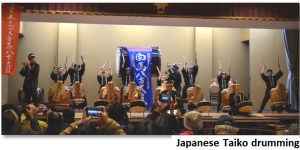 The joyous day was spent in visiting a shopping complex and listening to a musical performance of Japanese Taiko drumming. Taiko includes a broad range of Japanese percussion instruments.
The joyous day was spent in visiting a shopping complex and listening to a musical performance of Japanese Taiko drumming. Taiko includes a broad range of Japanese percussion instruments.
We participants cooked and offered Indian food to Okaasan and Otousan in reciprocation to their hospitality. The elders relished Indian-style food and showed their gratitude by saying Itadakimasu, a way to thank someone who has prepared our meal. As a kind gesture and to respect elders’ hospitality and love, the participants together said, gochisosama deshita i.e., ‘once again thanks for the meal’. Their culture is very similar to our Indian culture where people chant bhojan mantra by putting their hands together and reciting matra with devotion before meal.
Wearing a kimono, the traditional dress worn by Japanese women, in the night made us feel cozy and homey. Their youth and wedding pictures were interesting to see and characterized their culture. During the programme, the JICE coordinators accompanied the participants for translation purposes. The technologically advanced host family used Google Translator to communicate with us. But often we communicated non-verbally with each other. The proverb, ‘actions speak louder than words’ worked well. Our Japanese family were humble and their kind gestures blended with their own culture and tradition showed no undesirable ethnocentrism. The next morning, it was a pleasure to exchange gifts and souvenirs with the host family. During the homestay, every moment helped us experience a ‘daughter-parent’ bond with a touch of vasudhaiva kutumbakam, the Indian concept of seeing the world as one family and ‘Universal brotherhood’. The host family generously held a sendoff and then dropped the participants off at their hotel in Hakuba village.
Day 7: Sayonara, a Japanese way to say ‘goodbye’
The day cheered everyone because of the farewell party at the hotel, where the host family members of all the groups assembled together, and all the nations presented a cultural performance exhibiting the culture of their respective nations. The heightened fun continued – a group song was sung by all the host family members, the ‘Rice Cake’ making ceremony was done, and contact information shared – and ebbed only after the final sayonara was said. The farewell party was followed by a cultural experience of kimono wearing. Shakutabi, a group of women whose profession is to introduce Japanese culture to foreigners, taught us the way to wear a kimono, a traditional Japanese garment. The experience of wearing the traditional dress of Japan with accessories such as fans, umbrellas, games, etc., was fascinating.
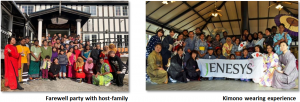
In the evening a workshop was conducted to compile our findings and the new discoveries deriving from Japan to draft an action plan. The exercise started at the individual level and ended at the group level with a detailed action plan emerging as an output. The action plan aimed to describe how the outcome and impact of the participants’ learning could be achieved among their fraternity and other groups after returning to their respective home countries. The day did end with an action plan, but insights on implementing the plan have yet to start.

Day 8: Long journey – but worth reaching
The long journey from Hakuba village ended in Tokyo where the Action Plan Reporting Session and Closing Ceremony of the JENESYS 2019 programme was conducted. Honorable Guests from the Embassies of India, Sri Lanka, Bhutan, Afghanistan, Pakistan, Nepal, Bangladesh and the Ambassador of the Maldives to Japan attended this session. Ministers from Japan’s Ministry of Foreign Affairs, Ministry of Agriculture, Forestry & Fisheries, and JICE were also present. Representatives from all the different countries briefed the audience on the knowledge obtained from Japan and the post-programme action plans. After the session, certificates were distributed to all the participants, and they also had an opportunity to interact with the various diplomats. The interaction with Mr Ranjan R Shenoy, Third Secretary (Political), and Mr Brahma Kumar, Counsellor (Political & IEC) from the Embassy of India helped us understand the policies in play between India-Japan, and India’s ongoing programmes to strengthen ties with Japan. It was certainly a grand gathering of diplomats and the future generation of all nations.

Day 9: All good things must come to an end
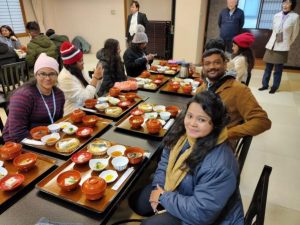 The Imperial Palace of Japan, which is the residence of the Emperor of Japan, and Aqua City Mall in Odaiba, a man-made island in the bay of Tokyo that came up on the final day was a visual treat. From Aqua City a magnificent view is spread out, including the bay of Tokyo, Rainbow Bridge, a Replica of the Statue of Liberty, etc. The trip came to an end on 03 December 2019, but not the learning. The way Japanese value time led us to think big – how nine days can be converted into approximately 7 lakh seconds. It was indeed a holistic programme that helped the participants grasp an all-inclusive picture of Japan.
The Imperial Palace of Japan, which is the residence of the Emperor of Japan, and Aqua City Mall in Odaiba, a man-made island in the bay of Tokyo that came up on the final day was a visual treat. From Aqua City a magnificent view is spread out, including the bay of Tokyo, Rainbow Bridge, a Replica of the Statue of Liberty, etc. The trip came to an end on 03 December 2019, but not the learning. The way Japanese value time led us to think big – how nine days can be converted into approximately 7 lakh seconds. It was indeed a holistic programme that helped the participants grasp an all-inclusive picture of Japan.
MY IMPRESSIONS
- People build a nation: Japan with its innovative outlook and dedicated workforce tries its best to overcome problems and succeed. The country is developed not only because of its advanced technology, but also because of its people. “All successes begin with self-discipline. It starts with you” – said Dwayne Johnson. The Japanese are very self-disciplined in terms of following laws/rules. As a testimony to their self-discipline, it was impressive to see everyone abiding by traffic rules and maintaining uniform space between each other – both while driving and at red lights. It was equally striking to see pedestrians crossing roads only at zebra crossings, when pedestrian signal lights turn green. Self-discipline is deep-rooted among the Japanese, from society to family to individual level, in all aspects. Their punctuality, promptness, integrity, and hard work make the work culture very organized, systematic, healthy and mutually helpful. Their cleanliness and hygienic practices is reflected everywhere. The harmonious cleanliness of their surroundings conveys a telling image of the healthy Japanese soul.
- Agriculture- and farmer-centric vision: Japan has great concern for its ageing farmers, and in keeping with this they focus on innovative agriculture and Smart Agriculture. Agricultural research and development is a major focus for both policy-makers and researchers in Japan. The concept of ‘direct sale shops’ to promote local sales of agricultural and livestock products is innovative and beneficial for both the farmers/producers as well as the consumers. It also reduces food miles, a strategy in making the environment sustainable. Promotion of village-tourism/agri-tourism is yet another innovative concept, wherein they scheduled our homestay in the house of the villagers, so that we can closely observe the local people and their culture and livelihood activities. The homestay was an opportunity to re-discover their culture. To make foreigners appreciate a nation’s own culture, the Shakutabi method may be followed and promoted in other countries also. It has the potential to generate livelihood and employment as well as to introduce the true Indian culture to visiting foreigners.
- University lights the lamp: We also found that an institution must have a museum of its own through which visitors can visualize the history and milestones achieved by the institution over the years.
- Only healthy food can bring health, and thereby a healthy life: One of the reasons behind the high life expectancy of the Japanese is their food culture. They value nutrients more than taste, and therefore they eat food in its natural form by minimally disturbing its natural state. As a result, Japanese keep themselves energetic and active throughout the day and stay strong and healthy.
- Protecting culture is more than ethnocentric: Japan is a modernized nation but not westernized because they keep their culture intact. It has safeguarded its intangible Asian cultural heritage over eons. The legacy and discipline inherited from their elders and forefathers is still being used by young Japanese to make right choices – thus making their future brighter, better, and sustainable.
- Well-planned action did it: The efforts made by the organizers with regard to overseas travel, accommodation, logistics, and food were meticulous. They are highly empathetic and made every moment comfortable which, in turn, enabled us to understand and learn better. Our days in Japan started with a morning call at 6.00 am, one hour before breakfast, followed by body temperature check and breakfast. Every day went well because of early starts, proper planning and execution, cooperative participants, and well-organized team management. It re-affirmed the value of morning hours.
- Feedback – A catalyst for improvement: I, now, take the freedom to offer a few suggestions that can help improve the programme. We will be deeply thankful if the program could be extended to a period of three weeks, so that more learning could take place. Also, I genuinely think that, since stakeholder institutions in agriculture are integral to a nation’s economy and development, participants need to be exposed to such institutions. Likewise, I feel it would greatly add value if there is some focus on tribal people, as well as on the gender component during such programmes.
- Heartfelt gratitude: I take this opportunity to express my sincere gratitude to JENESYS, the Government of India, the organizing team and everyone involved in making the visit successful. Equally, I extend my sincere gratitude to the Japanese people who inspired me by their self-discipline and integrity. On behalf of all the participants, I make a promise that we will surely move ahead with our action plan and use our learning for the betterment of our institutions and society.
Finally, I am grateful to the Embassy of India, Ministry of External Affairs, India, and Govind Ballabh Pant University of Agriculture and Technology, Pantnagar, for giving me this precious opportunity to represent India and experience a wonderful country like Japan. I am also thankful to the Ministry of Foreign Affairs, Japan, and the Japan International Cooperation Center (JICE) for organizing and structuring the whole programme in the best possible way and making it very useful. In conclusion I also wish to convey my gratitude to AESA for providing this wonderful platform to share my learning and findings from the JENESYS 2019 programme.

Ms. Pragya Goswamy, a second year PhD student, is from the Govind Ballabh Pant University of Agriculture and Technology, Pantnagar – 263145, Uttarakhand, India. (Email: pragya24goswamy@gmail.com)

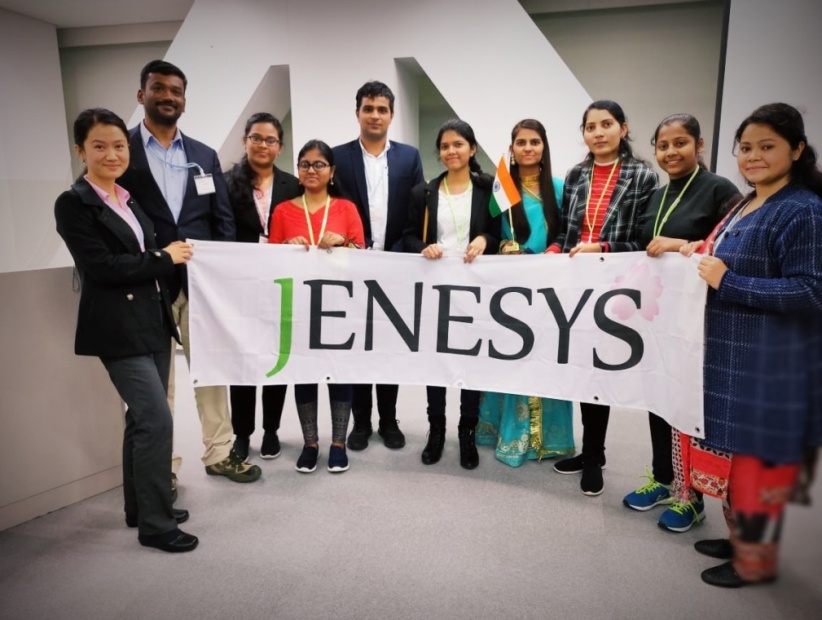
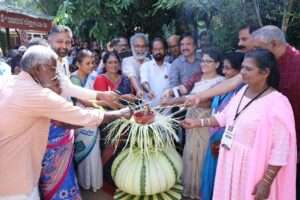

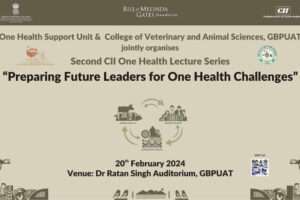
Youngsters like Pragya are an inspiration…at least students should care to read what she has written.